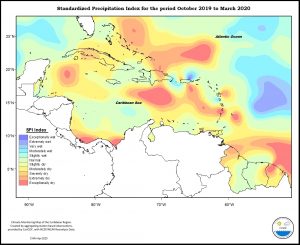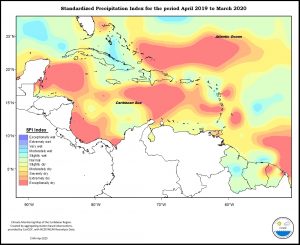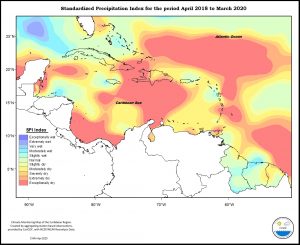The Caribbean Regional Climate Centre
Caribbean Institute for Meteorology and Hydrology
Husbands
St. James
Barbados BB23006
CONTACT US
P.O. Box 130
Bridgetown
Barbados
Tel : +1 (246) 425 1362/3
Fax: +1 (246) 424 4733
Email: rcc@cimh.edu.bb

SPEI March 2020
/in Climate Monitoring, SPEI /by Wayne DepradineSPI Change March 2020
/in Climate Monitoring, SPI Change /by Wayne DepradineSPI Monitor March 2020
/in Climate Monitoring, SPI Monitor /by Wayne DepradineMarch 2020
Mixed conditions prevailed throughout the islands of the eastern Caribbean during the month of March. Trinidad was severely dry in the west to slightly wet in the northeast; Tobago and Grenada normal; Barbados and St Vincent normal to slightly dry from south to north; Saint Lucia slight to moderately dry; Martinique moderately dry; Dominica normal in the south to moderately wet in the north; Guadeloupe exceptionally wet in the west to normal in the east; Antigua very wet in the south to moderately wet in the north; St Kitts moderate to slightly wet south to north; Anguilla and St Maarten moderately wet; St Croix extreme to exceptionally wet west to east; and St Thomas moderately wet. Conditions in the Guianas ranged from slightly wet in the northeast of Guyana and French Guyana to exceptionally dry in southern Guyana. Curacao was moderately wet. Puerto Rico ranged from normal in the south to exceptionally wet in the north east. Hispaniola ranged from very wet in western Dominican Republic to normal in northwest and southwest Haiti and to extremely wet in the east and slightly dry in the southeast. Jamaica ranged from severely dry to normal from west to east. Grand Cayman was severely dry and Cuba ranged from exceptionally dry in central areas to slightly dry in the west and normal in the east. Northern Bahamas was predominantly exceptionally dry and Belize ranged from slightly wet in the southeast to exceptionally dry in the north.
January to March 2020
October 2019 to March 2020
 Over the six month period, rainfall in the eastern Caribbean was predominantly normal to below normal with the exception of Dominica that was normal to moderately wet. Trinidad and St Croix were slight to moderately dry; Tobago, Antigua, St Kitts, Anguilla, St Maarten and St Thomas normal; Grenada normal to slightly dry from south to north; Barbados extreme to moderately dry from south to north; St Vincent extreme to exceptionally dry; Saint Lucia exceptional to severely dry; Martinique normal to moderately dry south to north; Guadeloupe normal to extremely dry west to east. In the Guianas, conditions ranged from normal in eastern Guyana and western Suriname to extremely dry in northern Guyana and exceptionally dry in north-eastern French Guiana. Curacao was moderately dry. Puerto Rico was predominantly normal with the exception of the extreme south east which was slight to moderately dry, the north west which was slight to severely dry and the north east which was slight to extremely wet. In Hispaniola, conditions ranged from normal in Haiti to moderately wet in eastern areas and slight to extremely dry in north central Dominican Republic. Jamaica ranged from slightly dry to normal from west to east, and Grand Cayman was slightly dry. Conditions in Cuba ranged from severely dry in west- central areas to normal in the east and west. Northern Bahamas ranged from severely dry to normal and Belize from slightly wet in the south to severely dry in the extreme west and slightly dry in the north.
Over the six month period, rainfall in the eastern Caribbean was predominantly normal to below normal with the exception of Dominica that was normal to moderately wet. Trinidad and St Croix were slight to moderately dry; Tobago, Antigua, St Kitts, Anguilla, St Maarten and St Thomas normal; Grenada normal to slightly dry from south to north; Barbados extreme to moderately dry from south to north; St Vincent extreme to exceptionally dry; Saint Lucia exceptional to severely dry; Martinique normal to moderately dry south to north; Guadeloupe normal to extremely dry west to east. In the Guianas, conditions ranged from normal in eastern Guyana and western Suriname to extremely dry in northern Guyana and exceptionally dry in north-eastern French Guiana. Curacao was moderately dry. Puerto Rico was predominantly normal with the exception of the extreme south east which was slight to moderately dry, the north west which was slight to severely dry and the north east which was slight to extremely wet. In Hispaniola, conditions ranged from normal in Haiti to moderately wet in eastern areas and slight to extremely dry in north central Dominican Republic. Jamaica ranged from slightly dry to normal from west to east, and Grand Cayman was slightly dry. Conditions in Cuba ranged from severely dry in west- central areas to normal in the east and west. Northern Bahamas ranged from severely dry to normal and Belize from slightly wet in the south to severely dry in the extreme west and slightly dry in the north.
April 2019 to March 2020
 Conditions in the eastern Caribbean over the twelve month period were predominantly normal to below normal, with the exception of a small area which includes Antigua that was normal to slightly wet. Trinidad was slight to extremely dry; Tobago normal to slightly dry; Grenada, Dominica, St Kitts, St Maarten and Anguilla normal; Barbados exceptional to severely dry; St Vincent severely dry; Saint Lucia extreme to predominantly exceptionally dry; Martinique moderate to extremely dry; Guadeloupe normal to extremely dry from west to east; St Thomas slight to moderately dry and St Croix severely dry. In the Guianas, conditions were mostly normal ranging to moderately wet in central Guyana and exceptionally dry on the northern Suriname/French Guiana border. Curacao was moderate to severely dry. Puerto Rico ranged from severely dry in the west to slightly wet in the north east. Over Hispaniola, conditions ranged from extremely dry in north and south Dominican Republic to normal over the majority of Haiti and eastern Dominican Republic. Jamaica was predominantly normal with the exception of slight to moderately dry conditions in the southwest and northwest, and slightly dry in the east. Grand Cayman was extreme to severely dry from west to east. Western Cuba ranged from normal to moderately dry, and from normal to moderately wet in the east of the country. Northern Bahamas ranged from moderately wet to extremely dry south to north, and Belize from normal in the extreme south to exceptionally dry in the north and west.
Conditions in the eastern Caribbean over the twelve month period were predominantly normal to below normal, with the exception of a small area which includes Antigua that was normal to slightly wet. Trinidad was slight to extremely dry; Tobago normal to slightly dry; Grenada, Dominica, St Kitts, St Maarten and Anguilla normal; Barbados exceptional to severely dry; St Vincent severely dry; Saint Lucia extreme to predominantly exceptionally dry; Martinique moderate to extremely dry; Guadeloupe normal to extremely dry from west to east; St Thomas slight to moderately dry and St Croix severely dry. In the Guianas, conditions were mostly normal ranging to moderately wet in central Guyana and exceptionally dry on the northern Suriname/French Guiana border. Curacao was moderate to severely dry. Puerto Rico ranged from severely dry in the west to slightly wet in the north east. Over Hispaniola, conditions ranged from extremely dry in north and south Dominican Republic to normal over the majority of Haiti and eastern Dominican Republic. Jamaica was predominantly normal with the exception of slight to moderately dry conditions in the southwest and northwest, and slightly dry in the east. Grand Cayman was extreme to severely dry from west to east. Western Cuba ranged from normal to moderately dry, and from normal to moderately wet in the east of the country. Northern Bahamas ranged from moderately wet to extremely dry south to north, and Belize from normal in the extreme south to exceptionally dry in the north and west.
April 2018 to March 2020
 Rainfall over the islands of the eastern Caribbean for the two year period was mostly normal to below normal, with the exception of Guadeloupe that was slightly wet to exceptionally dry from west to east. Trinidad was slight to exceptionally dry from the south east to the north west; Tobago severe to moderately dry; Grenada slightly dry; Barbados and Saint Lucia exceptionally dry; St Vincent extreme to exceptionally dry; Martinique severely dry; Dominica moderately dry in the south to normal in the north; Antigua and St. Thomas normal; St Kitts normal in the south to slightly dry in the north; St Maarten and St Croix moderately dry. Conditions in the Guianas ranged from moderately wet in the extreme southwest of Guyana and northern Suriname to extremely dry along the north-eastern coast of French Guiana. Curacao was moderate to severely dry. Puerto Rico ranged from severely dry in the extreme southwest to normal in the east. Hispaniola ranged from exceptionally dry in the west and south, to moderately dry in north central areas. Jamaica ranged from slightly wet in the west to severely dry in the east, whereas, Grand Cayman was severely dry. Cuba ranged from slightly wet in the extreme west to exceptionally dry in eastern areas. Northern Bahamas ranged from slightly wet to extremely dry, and Belize from normal in the south to exceptionally dry in the west, north and east.
Rainfall over the islands of the eastern Caribbean for the two year period was mostly normal to below normal, with the exception of Guadeloupe that was slightly wet to exceptionally dry from west to east. Trinidad was slight to exceptionally dry from the south east to the north west; Tobago severe to moderately dry; Grenada slightly dry; Barbados and Saint Lucia exceptionally dry; St Vincent extreme to exceptionally dry; Martinique severely dry; Dominica moderately dry in the south to normal in the north; Antigua and St. Thomas normal; St Kitts normal in the south to slightly dry in the north; St Maarten and St Croix moderately dry. Conditions in the Guianas ranged from moderately wet in the extreme southwest of Guyana and northern Suriname to extremely dry along the north-eastern coast of French Guiana. Curacao was moderate to severely dry. Puerto Rico ranged from severely dry in the extreme southwest to normal in the east. Hispaniola ranged from exceptionally dry in the west and south, to moderately dry in north central areas. Jamaica ranged from slightly wet in the west to severely dry in the east, whereas, Grand Cayman was severely dry. Cuba ranged from slightly wet in the extreme west to exceptionally dry in eastern areas. Northern Bahamas ranged from slightly wet to extremely dry, and Belize from normal in the south to exceptionally dry in the west, north and east.
Disclaimer
The information contained herein is provided with the understanding that The Caribbean Institute for Meteorology and Hydrology makes no warranties, either expressed or implied, concerning the accuracy, completeness, reliability, or suitability of the Outlook. The information may be used freely by the public with appropriate acknowledgement of its source, but shall not be modified in content and then presented as original material.
Mean Temperature Anomalies March 2020
/in Climate Monitoring, Mean Temperature Anomalies /by SherikaMarch 2020
January to March 2020
October 2019 to March 2020
April 2019 to March 2020
Mean Temperature for March 2020
Mean Temperature for the Period April 2019 to March 2020
Disclaimer
The information contained herein is provided with the understanding that The Caribbean Institute for Meteorology and Hydrology makes no warranties, either expressed or implied, concerning the accuracy, completeness, reliability, or suitability of the Outlook. The information may be used freely by the public with appropriate acknowledgement of its source, but shall not be modified in content and then presented as original material.
Temperature Outlook May June July 2020
/in CariCOF Climate Outlooks, Long Range Forecasts, Temperature Outlook /by SherikaMay June July 2020
August September October 2020
Precipitation Outlook May June July 2020
/in CariCOF Climate Outlooks, Long Range Forecasts, Precipitation Outlook /by SherikaWet Days and Wet Spells Outlooks May to July 2020
/in CariCOF Climate Outlooks, Long Range Forecasts, Wet Days and Wet Spells /by SherikaCariCOF Drought Outlook by the End of July 2020
/in CariCOF Climate Outlooks, Drought Outlook, Long Range Forecasts /by SherikaDry Spells Outlook for May to July 2020
/in CariCOF Climate Outlooks, Dry Spells Outlook, Long Range Forecasts /by Sherika